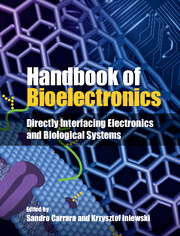Book contents
- Frontmatter
- Contents
- List of Contributors
- 1 What is bioelectronics?
- Part I Electronic components
- Part II Biosensors
- Part III Fuel cells
- Part IV Biomimetic systems
- Part V Bionics
- Part VI Brain interfaces
- Part VII Lab-on-a-chip
- 35 Lab-on-a-chip
- 36 CMOS spectrally multiplexed FRET contact imaging microsystem for DNA analysis
- 37 CMOS electrochemical biosensors: instrumentation and integration
- 38 Adaptive and reconfiguration-based error recovery in cyberphysical biochips
- 39 CMOS-based biomolecular sensor system-on-chip
- Part VIII Future perspectives
- Index
- References
35 - Lab-on-a-chip
from Part VII - Lab-on-a-chip
Published online by Cambridge University Press: 05 September 2015
- Frontmatter
- Contents
- List of Contributors
- 1 What is bioelectronics?
- Part I Electronic components
- Part II Biosensors
- Part III Fuel cells
- Part IV Biomimetic systems
- Part V Bionics
- Part VI Brain interfaces
- Part VII Lab-on-a-chip
- 35 Lab-on-a-chip
- 36 CMOS spectrally multiplexed FRET contact imaging microsystem for DNA analysis
- 37 CMOS electrochemical biosensors: instrumentation and integration
- 38 Adaptive and reconfiguration-based error recovery in cyberphysical biochips
- 39 CMOS-based biomolecular sensor system-on-chip
- Part VIII Future perspectives
- Index
- References
Summary
Most probably, the term “lab-on-a-chip” came into the publicdomain with a nice publication that appeared in ScientificAmerican in 2007. That paper focused on recent developments intiny and portable chips for rapid testing in blood samples for pathogens orbiological weapons [1]. The article emphasized microfluidics as a keyfeature of the chip in order to make the lab-on-a-chip practical. The use ofair pressure or electricity is presented as the way to move and preciselymanipulate microscopic droplets through tiny chemical-reaction chambers [1].This sentence shows us the intimate connection between lab-on-a-chip andbioelectronics: we need electronics for precisely manipulating microscopicdroplets that contain pathogens or biological weapons. More than that, wealso need on board a quantitative technique for quantifying the pathogens orthe toxic agents. Therefore, biosensors are immediately involved. Figure35.1 schematically shows this deep interconnection addressed by modernsystems: a platform on a silicon chip that hosts a complex network ofmicrofluidic chambers and channels operating differently, and intimatelyintegrated with a complex microelectronic system. The whole system presentsloading ports for injection of samples and reagents. The loaded materialsare then mixed and pushed to the first reaction chamber by compressed air(as in point 1 of Figure 35.1) or by electrical or magnetic fields. Thereaction chamber performs thermal cycles to assure PCR (polymerase chainreaction) amplification (point 2 in Figure 35.1). In principle, a similarreaction chamber in the chip may perform other chemical reactions requiredby the assay (e.g. combination with another molecule to extract the targetmolecule from a complex). Then the reagent products are further moved intoanother reaction chamber to let a second reaction occur (point 3). Thesecond reaction may be required by the detection method. For example, areaction with a label (e.g. gold nanoparticles or fluorescent dyes) may beprovided in the case of labelled detection. Finally, the marked productsarrive in the analysis chamber, and the products are detected (point 4). Inthe example of Figure 35.1, the detection is provided by a series of diodesthat detect the pathogens as well as by electrophoretic tests.
Information
- Type
- Chapter
- Information
- Handbook of BioelectronicsDirectly Interfacing Electronics and Biological Systems, pp. 425 - 429Publisher: Cambridge University PressPrint publication year: 2015
